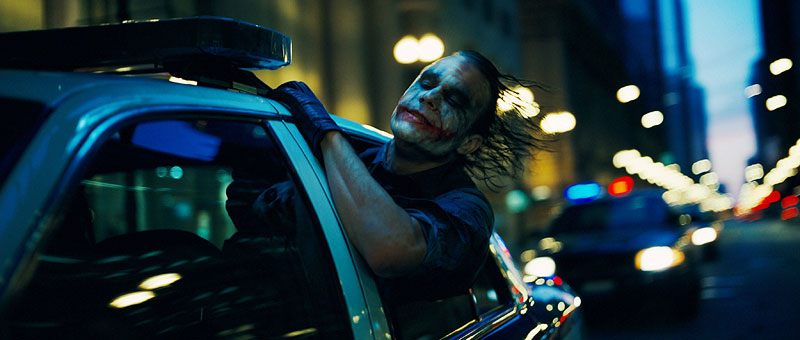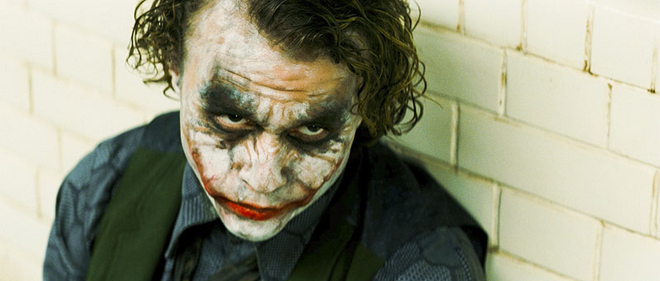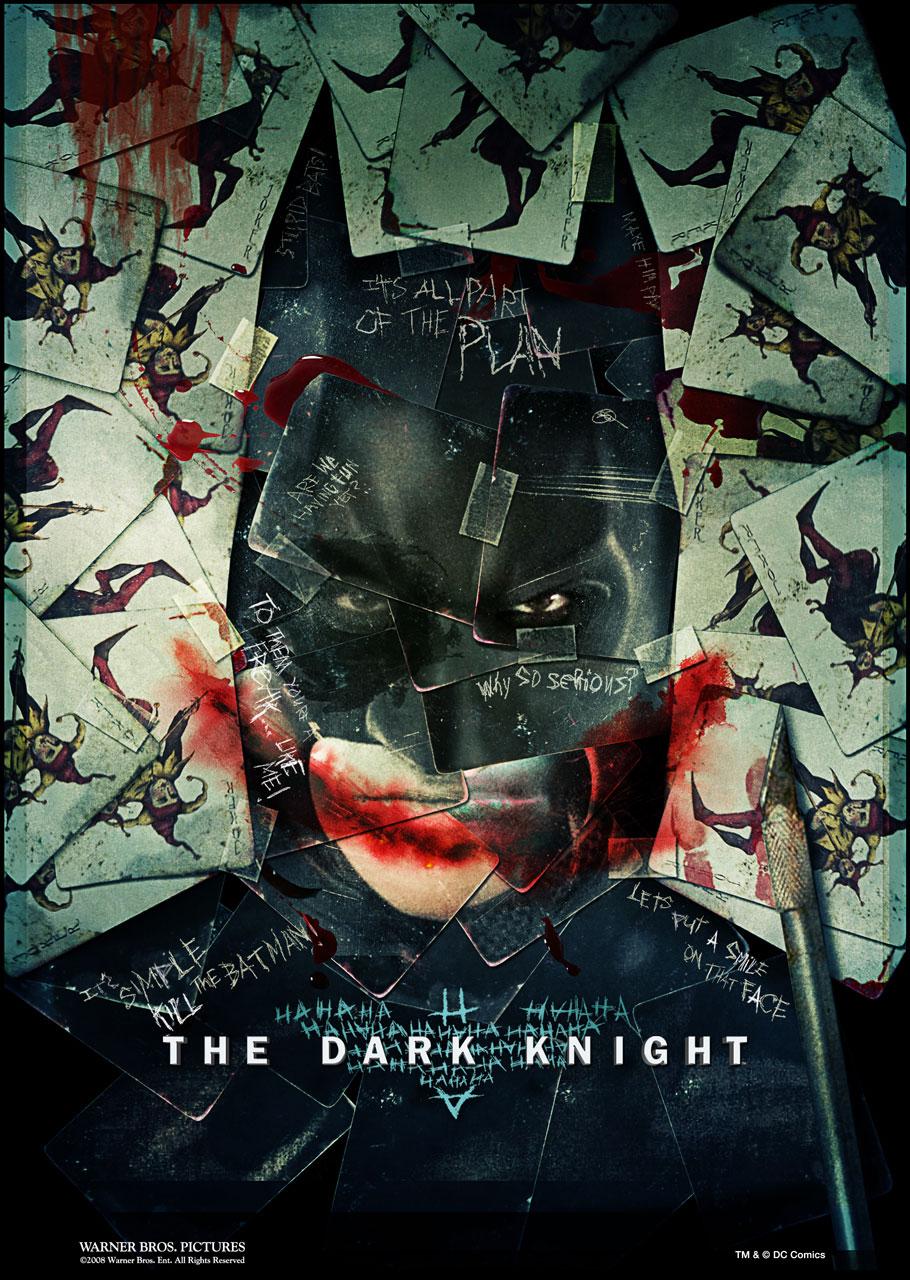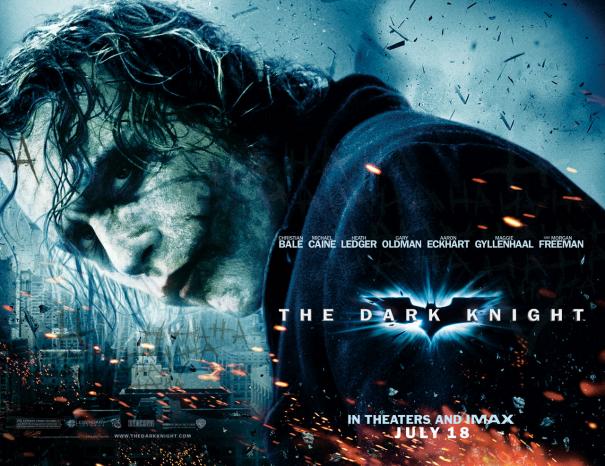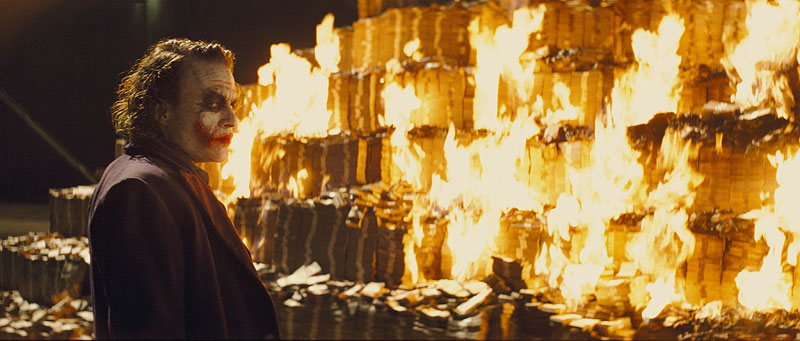
Holy Catastrophic Wreck of a City, Batman! After two viewings, I’m happy to report
Christopher Nolan’s moody, sinister The Dark Knight was well worth the wait, and bears the high expectations set for it quite impressively. In fact, at two and a half hours (which zip along, and even feel somewhat truncated at times — see below), this sprawling Gotham crime saga is almost too much movie to take in the first time around. To be sure,
The Dark Knight isn’t perfect — It still has a few of the problems of
Batman Begins: Once again, there’s a lot of comic-book speechifyin’ going on (Michael Caine’s Alfred is particularly Yoda-ish at times), some leaps in logic are occasionally required, and the fight sequences can be hard to follow at first — but all of these are readily forgivable given both the ambition and scope Nolan is working with here and the sheer entertainment value of the film.
Most importantly, if Begins, as I said in 2005, was “the Batman movie that fans of the Dark Knight have been waiting for,” this is undoubtedly the Joker movie we’ve all been hoping for as its companion, particularly in light of Jack Nicholson’s one-note grandstanding way back in 1989. Heath Ledger here is a true force of nature, embodying to a tee the malevolent, frighteningly insane jester of The Killing Joke and The Dark Knight Returns — He has to be considered a lock for Best Supporting Actor next year.
Some spoilers will likely follow in the paragraphs to come, so, if you want to go in completely fresh, I’ll leave it at this: WALL-E is up there, but right now The Dark Knight is without a doubt the film of the year, and far and away the best superhero movie out since Spiderman 2 or The Incredibles. True, some might find this vision of Gotham too relentlessly downbeat for their taste. But, if like me, you take your Batman black, you’re in for a real treat.
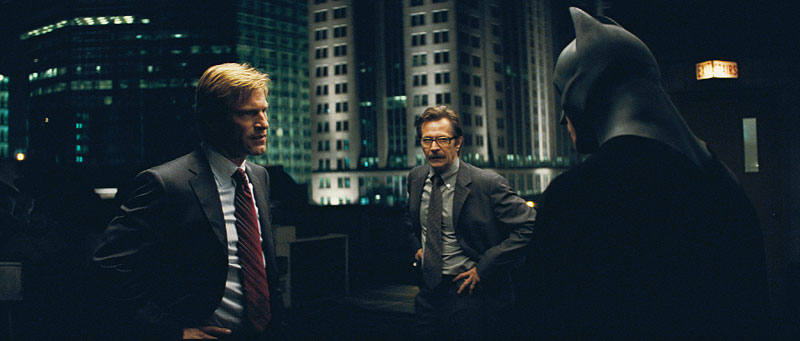 The Dark Knight begins with a taste of things to come — Six masked clowns descend upon a downtown Gotham bank, owned by the mob and run by Heat‘s William Fichtner, and only one drives out, with $68 million in lucre and another boost for his burgeoning notoriety. We then are introduced to the three men leading the fight to take back Gotham City from the criminal hordes: Lt. Jim Gordon (Gary Oldman), now running his own MCU; recently-elected DA and Kennedyesque “white knight” of Gotham Harvey Dent (Aaron Eckhart), and of course, the Batman (Christian Bale), still striking fear in the hearts of Gotham’s underworld…and inspiring a few copycats. With Gordon following the money, Dent handing down indictments, and the Batman enforcing the law (if sometimes by circumventing it), this trifecta of concerned citizens — aided by ADA Rachel Dawes (Maggie Gyllenhaal), caught in a McNulty–Daniels–Pearlman love triangle of sorts — have put the squeeze to the remaining Mob factions, who’ve reorganized into their own version of the New Day Co-Op. (Yes, as this paragraph attests, this version of Gotham comes off very Wiry at times.)
The Dark Knight begins with a taste of things to come — Six masked clowns descend upon a downtown Gotham bank, owned by the mob and run by Heat‘s William Fichtner, and only one drives out, with $68 million in lucre and another boost for his burgeoning notoriety. We then are introduced to the three men leading the fight to take back Gotham City from the criminal hordes: Lt. Jim Gordon (Gary Oldman), now running his own MCU; recently-elected DA and Kennedyesque “white knight” of Gotham Harvey Dent (Aaron Eckhart), and of course, the Batman (Christian Bale), still striking fear in the hearts of Gotham’s underworld…and inspiring a few copycats. With Gordon following the money, Dent handing down indictments, and the Batman enforcing the law (if sometimes by circumventing it), this trifecta of concerned citizens — aided by ADA Rachel Dawes (Maggie Gyllenhaal), caught in a McNulty–Daniels–Pearlman love triangle of sorts — have put the squeeze to the remaining Mob factions, who’ve reorganized into their own version of the New Day Co-Op. (Yes, as this paragraph attests, this version of Gotham comes off very Wiry at times.)
But, in their desperation, the Mob goes Marlo one step further, and places their trust in the deranged madman in greasepaint who stole their money in the first reel. Handy with knives, pencils, motivational tactics, and The Anarchist Cookbook, this Joker is in effect the criminal countermeasure to the Batman…except, it turns out, he could pretty much care less about the Mob, their money, or really anything else. Rather, as Alfred puts it, he “just wants to watch the world burn,” and before he’s fully indulged his whims of fancy, all of Gotham’s heroes — and the city itself — will face his devilishly inspired moral quandaries, no-win situations that will test their character…and, more often than not, destroy them.
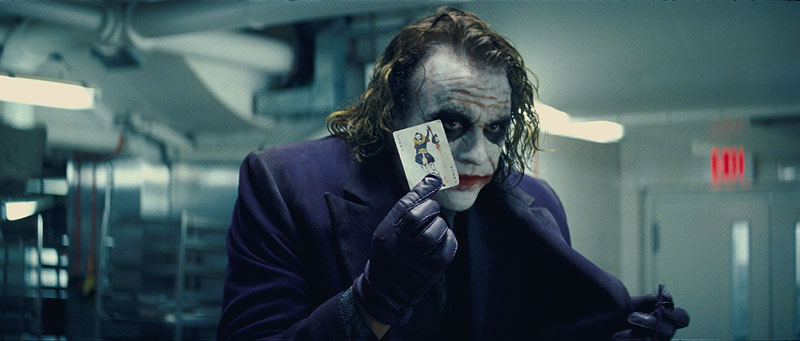 So, yes, folks, despite all the quality actors on display here (special kudos to Eckhart and Oldman) and the titular Dark Knight, this is ultimately the Clown Prince of Crime’s movie…and he’s a real kick. As I noted above, Jack Nicholson’s portrayal of “Jack Nicholson” playing the Joker was a disappointment to me even when I was fifteen years old. But this is the scary clown I’ve been looking to see. Lolling his tongue obscenely along the scars in his mouth, chirping about madness, mayhem, lepers and crooks in his grotesque singsong, laughing hilariously to himself about gags only he would find remotely funny, this Joker, “like a dog chasing a car,” is note-perfect throughout. Ledger has so many great moments in this film that it’d be impossible to enumerate them all here. Suffice to say, he (and Nolan) got it: The Joker’s knowing, even admiring co-dependence with Batman (“You complete me!), his shifty-cowardly fighting style (i.e. throw goons in the way and look for the occasional shiv), his taste for the theatrical murder (note, for example, those video interrogations)…Ledger delved right past all the campy cruft surrounding the character for years and burrowed right into the clown’s dark heart. Every plaudit you’ve heard about him is fully deserved — it’s really an amazing performance.
So, yes, folks, despite all the quality actors on display here (special kudos to Eckhart and Oldman) and the titular Dark Knight, this is ultimately the Clown Prince of Crime’s movie…and he’s a real kick. As I noted above, Jack Nicholson’s portrayal of “Jack Nicholson” playing the Joker was a disappointment to me even when I was fifteen years old. But this is the scary clown I’ve been looking to see. Lolling his tongue obscenely along the scars in his mouth, chirping about madness, mayhem, lepers and crooks in his grotesque singsong, laughing hilariously to himself about gags only he would find remotely funny, this Joker, “like a dog chasing a car,” is note-perfect throughout. Ledger has so many great moments in this film that it’d be impossible to enumerate them all here. Suffice to say, he (and Nolan) got it: The Joker’s knowing, even admiring co-dependence with Batman (“You complete me!), his shifty-cowardly fighting style (i.e. throw goons in the way and look for the occasional shiv), his taste for the theatrical murder (note, for example, those video interrogations)…Ledger delved right past all the campy cruft surrounding the character for years and burrowed right into the clown’s dark heart. Every plaudit you’ve heard about him is fully deserved — it’s really an amazing performance.
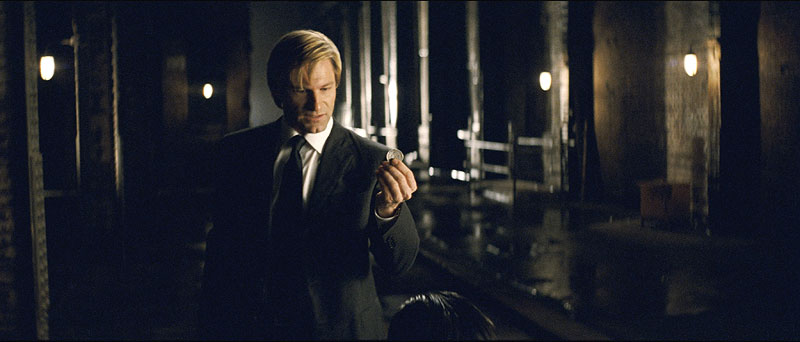 Of course, the Joker isn’t the only villain of the piece. Of the other main Rogues’ Gallery entrant, I loved the slow build-up to his “origin” — for once, Two-Face had real dramatic and even tragic heft on the screen. (I’m a fan of Tommy Lee Jones, but I hope he sees this movie somewhere and feels downright lousy.) That being said, it’s hard to escape the slight feeling that he — as a villain, anyway — is shoehorned into the story somewhat. Given how fast they try to run through the Two-Face storyline near the end, it might’ve made more sense just to set him up for the next installment. (Speaking of which, given that Nolan rectified Tim Burton’s horrendous error of killing the Joker this time (a cruel irony, in light of recent events), I’m of the opinion currently congealing in fanboy circles that Dent was unconscious in the last scene, and will be shipped off to Arkham under a fake name, by (secret) order of Gordon, should the series continue.)
Of course, the Joker isn’t the only villain of the piece. Of the other main Rogues’ Gallery entrant, I loved the slow build-up to his “origin” — for once, Two-Face had real dramatic and even tragic heft on the screen. (I’m a fan of Tommy Lee Jones, but I hope he sees this movie somewhere and feels downright lousy.) That being said, it’s hard to escape the slight feeling that he — as a villain, anyway — is shoehorned into the story somewhat. Given how fast they try to run through the Two-Face storyline near the end, it might’ve made more sense just to set him up for the next installment. (Speaking of which, given that Nolan rectified Tim Burton’s horrendous error of killing the Joker this time (a cruel irony, in light of recent events), I’m of the opinion currently congealing in fanboy circles that Dent was unconscious in the last scene, and will be shipped off to Arkham under a fake name, by (secret) order of Gordon, should the series continue.)
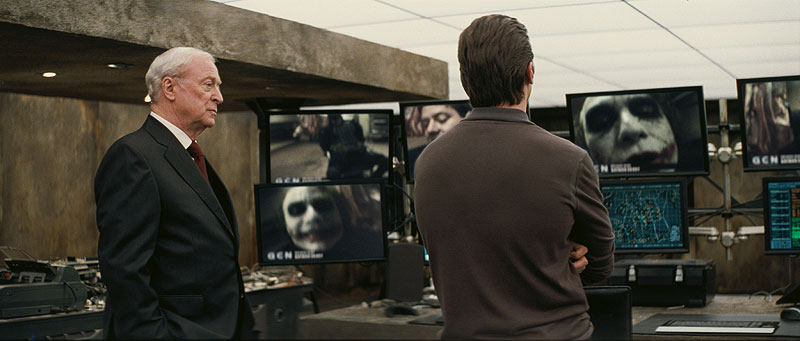 And the other villain of The Dark Knight — besides mobsters Eric Roberts and Michael Jai White, that is — is the Batman himself, who contracts a passing case of the Dubyas as the film progresses (much to Morgan Freeman’s consternation.) True, the warrantless wiretap incident also seems slightly shoehorned in to some extent, but I applaud the brothers Nolan for bringing in some post-9/11 deepthink into the equation. (Don’t worry — it’s nowhere near as exploitative as Cloverfield.) As the Joker spreads fear through Gotham, by way of targeted bombings and bridge-and-tunnel threats, the authorities behave increasingly badly to keep up, from harsh interrogations to phone taps to ultimately, the murderous vigilantism of Two-Face. But, despite the occasional smoldering ruin and grieving firemen, the analogy is never cut-and-dried, and, eventually, we’re all implicated. When fear runs your city, nobody’s thinking too clearly. (Or, as the Joker puts it, “When the chips are down, these civilized people will eat each other.” — Note also his veiled war-in-Iraq commentary, about truckloads of dead soldiers being “all part of the plan.”)
And the other villain of The Dark Knight — besides mobsters Eric Roberts and Michael Jai White, that is — is the Batman himself, who contracts a passing case of the Dubyas as the film progresses (much to Morgan Freeman’s consternation.) True, the warrantless wiretap incident also seems slightly shoehorned in to some extent, but I applaud the brothers Nolan for bringing in some post-9/11 deepthink into the equation. (Don’t worry — it’s nowhere near as exploitative as Cloverfield.) As the Joker spreads fear through Gotham, by way of targeted bombings and bridge-and-tunnel threats, the authorities behave increasingly badly to keep up, from harsh interrogations to phone taps to ultimately, the murderous vigilantism of Two-Face. But, despite the occasional smoldering ruin and grieving firemen, the analogy is never cut-and-dried, and, eventually, we’re all implicated. When fear runs your city, nobody’s thinking too clearly. (Or, as the Joker puts it, “When the chips are down, these civilized people will eat each other.” — Note also his veiled war-in-Iraq commentary, about truckloads of dead soldiers being “all part of the plan.”)
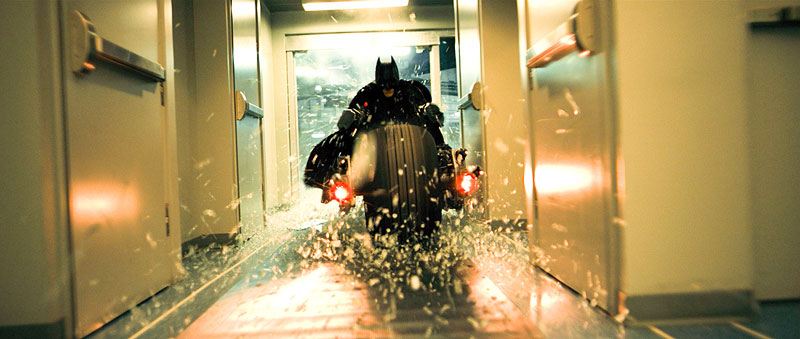 For all the upside of The Dark Knight, there are still problems here, to be sure. Perhaps I was sitting too close the first time, but some of the action sequences — most notably the final one (needlessly enhanced by the video game sonar, even if the white eyes were a nice fanboy touch) were hard to follow the first time through. (Everything made more sense the second time.) For all its 152 minutes, The Dark Knight still feels weirdly truncated at times, particularly in the final act. (The Rangoon, “watch the world burn” scene in the middle going also seems haphazardly thrown into the mix.) And, perhaps most problematic, characters have a tendency throughout to just show up and/or disappear without explanation. Where did the Joker go after Batman leaves the fundraiser? How did Bruce know the Joker was coming in the first place? How did Batman find Dent when he’s interrogating the Joker’s goon? Why was Eric Roberts (standing on his own two legs, no less) just sorta hanging around outside you-know-who’s hospital room? You could just chalk it up to comic-book pacing, I suppose, but these moments still felt entirely too convenient a lot of the time. (I guess one could also complain about the depth of the Jokers’ ruses — the shattered-bullet fingerprint and phone-“contusion” come to mind — but that was a case where I figured comic book rules sufficed to explain things.)
For all the upside of The Dark Knight, there are still problems here, to be sure. Perhaps I was sitting too close the first time, but some of the action sequences — most notably the final one (needlessly enhanced by the video game sonar, even if the white eyes were a nice fanboy touch) were hard to follow the first time through. (Everything made more sense the second time.) For all its 152 minutes, The Dark Knight still feels weirdly truncated at times, particularly in the final act. (The Rangoon, “watch the world burn” scene in the middle going also seems haphazardly thrown into the mix.) And, perhaps most problematic, characters have a tendency throughout to just show up and/or disappear without explanation. Where did the Joker go after Batman leaves the fundraiser? How did Bruce know the Joker was coming in the first place? How did Batman find Dent when he’s interrogating the Joker’s goon? Why was Eric Roberts (standing on his own two legs, no less) just sorta hanging around outside you-know-who’s hospital room? You could just chalk it up to comic-book pacing, I suppose, but these moments still felt entirely too convenient a lot of the time. (I guess one could also complain about the depth of the Jokers’ ruses — the shattered-bullet fingerprint and phone-“contusion” come to mind — but that was a case where I figured comic book rules sufficed to explain things.)
 But, minor quibbling aside, The Dark Knight is an exemplary sequel, and easily the best of the seven Batfilm incarnations thus far. Which begs the question: After the dastardly depths of Ledger’s Joker, where could Nolan & co. possibly go next? Everyone’s signed for three films, and — of the main villains — we still have the Penguin (Ray Winstone? Phillip Seymour Hoffman?), the Riddler (Guy Pearce? Paul Bettany?), and the Catwoman (Shannyn Sossamon? Jessica Biel?), the first two of which don’t seem to fit the Nolanverse particularly well. (Neither, for that matter, does Robin.) I suppose the Joker could return, but that obviously opens up a huge can of worms now. (Perhaps Joseph Gordon-Levitt? He looks eerily like Ledger anyway.) My first thought when the cliffhanger of a sort was set up was this (probably because I’d just seen Dr. Manhattan doing the Feds’ dirty work), but I’m sure that’s way too out there for the franchise.
But, minor quibbling aside, The Dark Knight is an exemplary sequel, and easily the best of the seven Batfilm incarnations thus far. Which begs the question: After the dastardly depths of Ledger’s Joker, where could Nolan & co. possibly go next? Everyone’s signed for three films, and — of the main villains — we still have the Penguin (Ray Winstone? Phillip Seymour Hoffman?), the Riddler (Guy Pearce? Paul Bettany?), and the Catwoman (Shannyn Sossamon? Jessica Biel?), the first two of which don’t seem to fit the Nolanverse particularly well. (Neither, for that matter, does Robin.) I suppose the Joker could return, but that obviously opens up a huge can of worms now. (Perhaps Joseph Gordon-Levitt? He looks eerily like Ledger anyway.) My first thought when the cliffhanger of a sort was set up was this (probably because I’d just seen Dr. Manhattan doing the Feds’ dirty work), but I’m sure that’s way too out there for the franchise.
In any case, here’s hoping they figure it out. But, even if they don’t, The Dark Knight will stand tall in the annals of the caped crusader. Near the end, the Joker tells Batman, “You and I could do this forever.” That’s how I like to think of this incarnation of the Clown and the Bat, now forever locked in their eternal dance. Even if we’ll never see it, I know Ledger’s Joker will continue to break out of Arkham, terrorize Gotham, and haunt its winged guardian for years and decades to come. Long after the actor’s death, his masterful creation will continue to get the last laugh.
